The Fantom VENOM8 is the company’s newest high-performance line of NVMe SSDs to hit the market. Purpose-built for gaming, media professionals, and business applications, the VENOM8 features the PCIe Gen4 interface and is powered by 176-Layer 3D NAND technology, SK Hynix DDR4 DRAM Cache, and Phison E18 controller.
It’s also fully compatible with the PlayStation 5, so you can add a substantial amount of storage to your current-gen console. The VENOM8 is available in capacities from 1TB to 4TB.
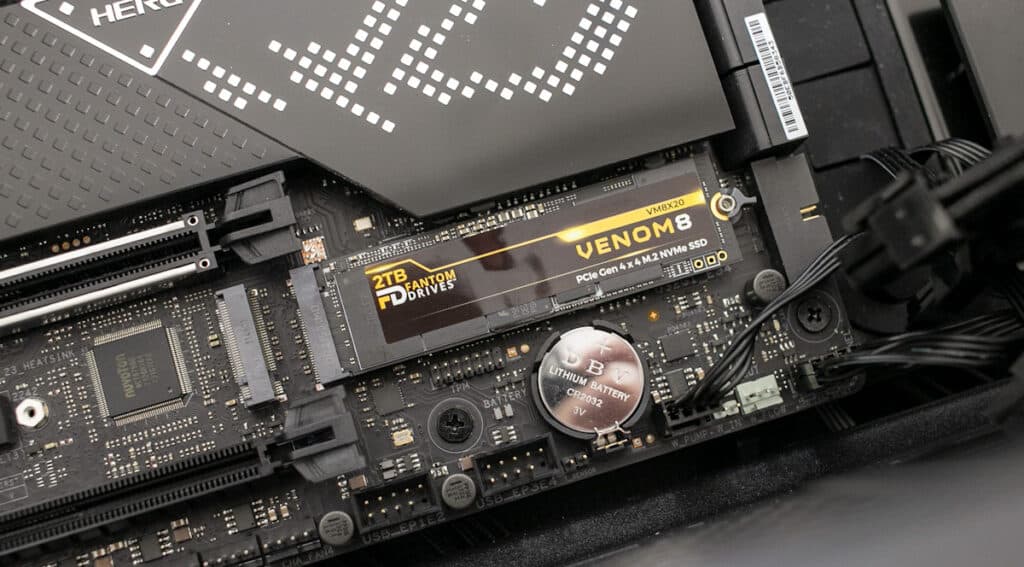 Fantom VENOM8 Features
Fantom VENOM8 Features
For performance, the VENOM8 is quoted with the speeds we usually see from PCIe Gen4 TLC drives, including 7.4GB/s in sequential reads across all capacities. For sequential writes, the 4TB and 2TB are expected to deliver up to 6.9GB/s; however, the 1TB model is specced a little slower at 6GB/s.
The new Fantom drive also features an endurance of up to 3,000 TBW (total bytes written) with an MTBF rating of 1.6 million hours. These specifications are all par for the course when it comes to the premium consumer Gen4 drives, so not much stands out until we hit the performance section below.
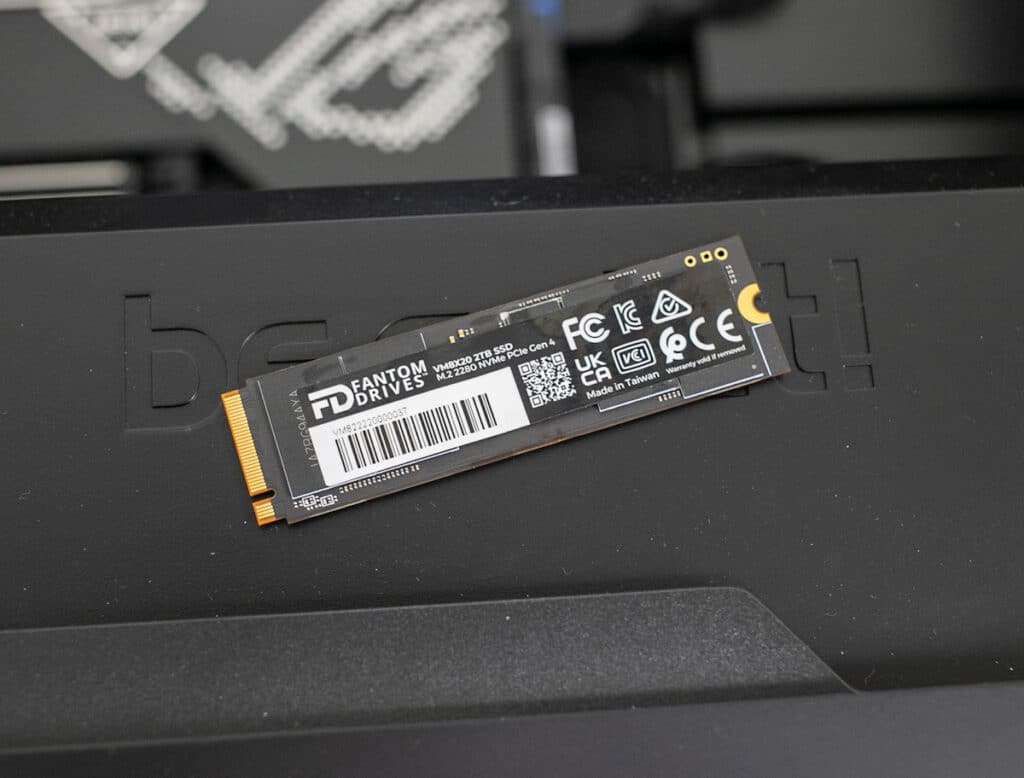
Fantom VENOM8 offers TRIM support, allowing the SSD to tell the OS which data blocks are no longer necessary so they can be used for rewriting and speeding up overall performance. It also features AES 256-Bit encryption, SMART (Self-Monitoring Analysis and Reporting Technology), Autonomous Power State Transition (APST), end-to-end data path protection, and LDPC ECC algorithm.
Backed by a 5-year warranty, the VENOM8 goes for roughly $105 (1TB), $205 (2TB), and $540 (4TB) at Amazon at the time of this review. We are looking at the 2TB model for this review.
Fantom VENOM8 Specifications
| Capacities |
|
| Flash Memory | Micron 3D NAND (TLC) |
| Interface |
|
| Form Factor | M.2 2280 |
| DRAM Cache | SK hynix DDR4 |
| Endurance |
|
| MTBF | 1.6 million hours |
| Maximum Power Consumption |
|
| Temperatures |
|
| Dimensions | 80.00mm (L) x 22.00mm (W) x 2.15mm (H) |
| Advanced Features | TRIM support, AES 256-Bit encryption, SMART (Self-Monitoring Analysis and Reporting Technology), APST, End-to-end data path protection and LDPC ECC algorithm. |
| Warranty | 5-years |
Fantom VENOM8 Performance
For database and synthetic testing, we leverage the Lenovo ThinkSystem SR635 server, equipped with an AMD 7742 CPU and 512GB of 3200Mhz DDR4 memory. NVMe is tested natively through an M.2 to PCIe adapter card in the edge-card slot. A large focus is put on drive latency across the entire load range of the drive, not just at the smallest QD1 (Queue-Depth 1) levels. We do this because many of the common consumer benchmarks don’t adequately capture end-user workload profiles. For our added BlackMagic Disk Speed Test performed in Windows, we use our self-built StorageReview desktop.
We are reviewing the 2TB version of the Fantom VENOM8 drive and will be comparing it to the following PCIe Gen4x4 drives:
Fantom VENOM8 SQL Server Performance
Each SQL Server VM is configured with two vDisks: 100GB volume for boot and a 500GB volume for the database and log files. From a system resource perspective, we configured each VM with 16 vCPUs, 64GB of DRAM and leveraged the LSI Logic SAS SCSI controller. While our Sysbench workloads tested previously saturated the platform in both storage I/O and capacity, the SQL test is looking for latency performance.
This test uses SQL Server 2014 running on Windows Server 2012 R2 guest VMs and is stressed by Quest’s Benchmark Factory for Databases. StorageReview’s Microsoft SQL Server OLTP testing protocol employs the current draft of the Transaction Processing Performance Council’s Benchmark C (TPC-C), an online transaction-processing benchmark that simulates the activities found in complex application environments.
The TPC-C benchmark comes closer than synthetic performance benchmarks to gauging the performance strengths and bottlenecks of storage infrastructure in database environments. Each instance of our SQL Server VM for this review uses a 333GB (1,500 scale) SQL Server database and measures the transactional performance and latency under a load of 15,000 virtual users.
SQL Server Testing Configuration (per VM)
- Windows Server 2012 R2
- Storage Footprint: 600GB allocated, 500GB used
- SQL Server 2014
-
- Database Size: 1,500 scale
- Virtual Client Load: 15,000
- RAM Buffer: 48GB
- Test Length: 3 hours
-
- 2.5 hours preconditioning
- 30 minutes sample period
Starting with SQL average latency, the Fantom VENOM8 showed 3ms, which placed it in the upper part of the consumer NVMe SSD leaderboard (right next to the new Samsung 990 Pro).
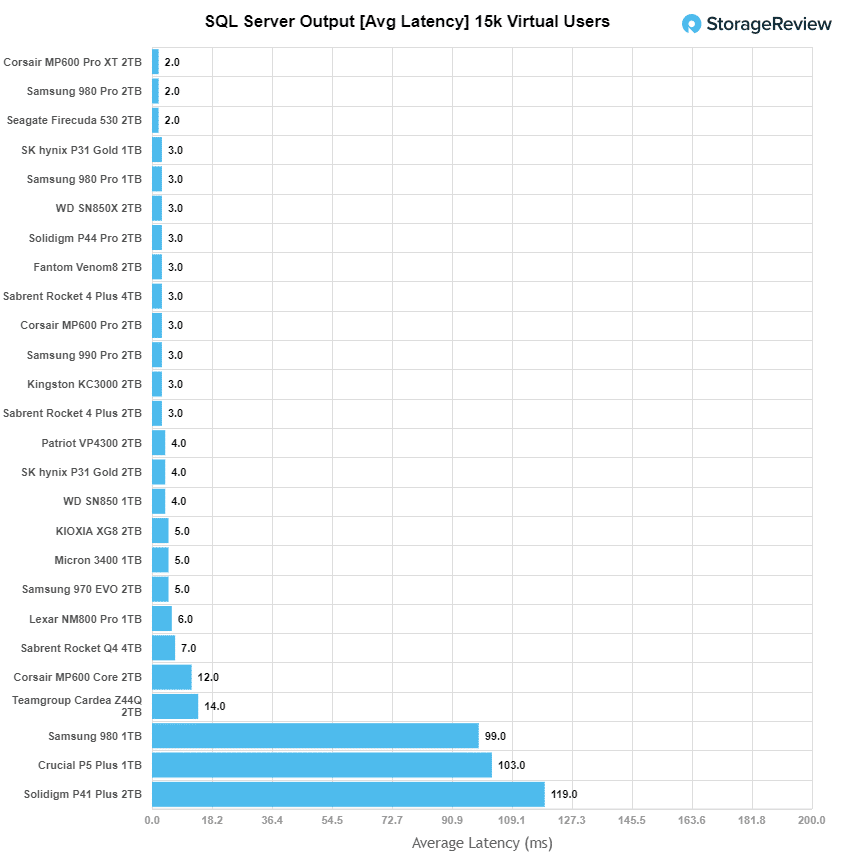
BootBench
BOOT-BENCH-1 is a workload profile adopted by OCP to profile SSDs that are designed for server boot duty. While this is intuitively a job for enterprise SSDs, client SSDs are often selected for their performance, capacity, and cost combination. The boot drive issue is germane not just to hyperscalers, but also to server and storage system providers as well as they face similar challenges.
This boot workload executes a relatively intense test plan that fills the drive entirely with writes before testing a read-heavy workload sequence. For each test, it performs a 32K random read async operation alongside a 15MiB/s synchronous 128k random write as well as a 5MiB/s synchronous 128k random write/trim background workload. The script starts with the random-read activity at a 4-job level and scales up to 256-jobs at its peak. The final result is the read-operations performed during its peak run.
The OCP goal for this benchmark is a pass/fail at 60K read IOPS. Most drives we test will far exceed the minimum, but the results are instructive regardless.
| SSD | Read IOPS |
| Sk hynix Platinum P41 | 220,884 IOPS |
| WD SN850X | 219,883 IOPS |
| Solidigm P44 Pro | 211,999 IOPS |
| Fantom VENOM8 | 190,573 IOPS |
| Samsung 990 Pro | 176,677 IOPS |
| Sabrent Rocket 4 Plus | 162,230 IOPS |
In this benchmark, the Fantom VENOM8 performs, hitting the 191K IOPS mark, which places it near the middle of the pack. It fell behind the newly released Solidigm P44 Pro, as well as the WD and Sk hynix drives, the latter of which posted a top-performing 221K IOPS. It did, however, show better boot workload performance than the Samsung 990 Pro.
VDBench Workload Analysis
When it comes to benchmarking storage devices, application testing is best, and synthetic testing comes in second place. While not a perfect representation of actual workloads, synthetic tests do help to baseline storage devices with a repeatability factor that makes it easy to do an apples-to-apples comparison between competing solutions. These workloads offer a range of different testing profiles ranging from “four corners” tests, common database transfer size tests, to trace captures from different VDI environments.
All of these tests leverage the common vdBench workload generator, with a scripting engine to automate and capture results over a large compute testing cluster. This allows us to repeat the same workloads across a wide range of storage devices, including flash arrays and individual storage devices. Our testing process for these benchmarks fills the entire drive surface with data, then partitions a drive section equal to 1% of the drive capacity to simulate how the drive might respond to application workloads. This is different from full entropy tests which use 100% of the drive and take them into a steady state. As a result, these figures will reflect higher-sustained write speeds.
Profiles:
- 4K Random Read: 100% Read, 128 threads, 0-120% iorate
- 4K Random Write: 100% Write, 64 threads, 0-120% iorate
- 64K Sequential Read: 100% Read, 16 threads, 0-120% iorate
- 64K Sequential Write: 100% Write, 8 threads, 0-120% iorate
Starting with 4k random read, the Fantom VENOM8 showed mid-range performance (or 4th place), showing a peak of 679K IOPS at a latency of 219.1µs. As you can see below, this was essentially the same as the FireCuda’s peak performance.
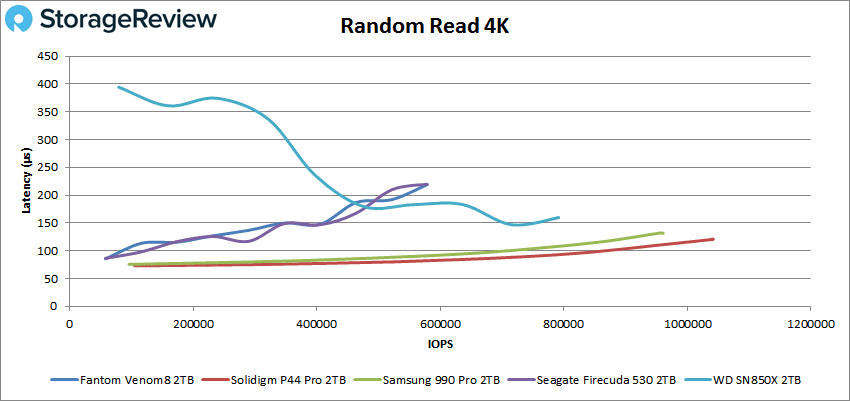
For 4K random write, Fantom VENOM8 latency posted excellent results, peaking at 598K IOPS and 208.1ms, which placed it first among all tested drives.
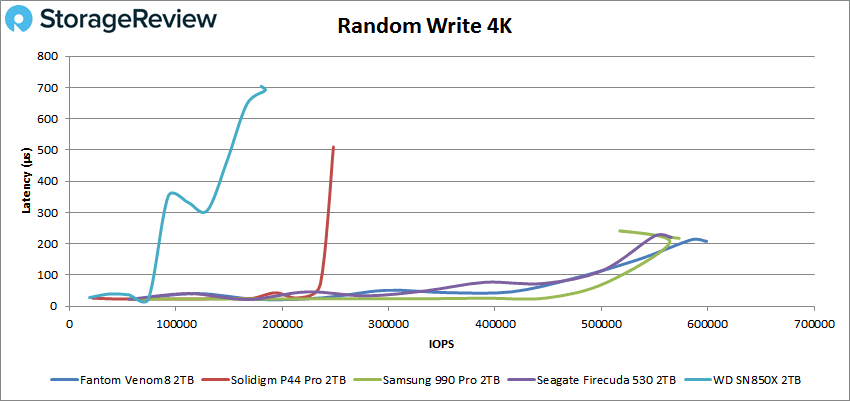
Switching to sequential workloads, where we look at our 64K tests, the Fantom VENOM8 showed strong performance once again. In reads, the Fantom VENOM8 placed 3rd (a hair behind the Seagate FireCuda 530) with a peak throughput of 90K IOPS (or 5.6GB/s) with a latency of 355.8µs.
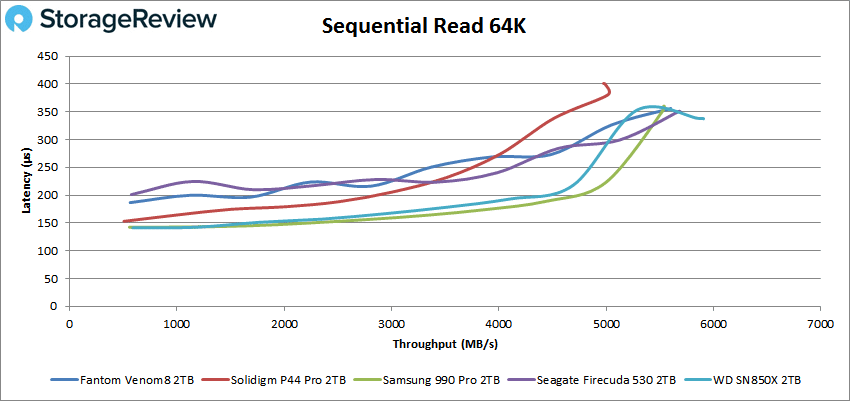
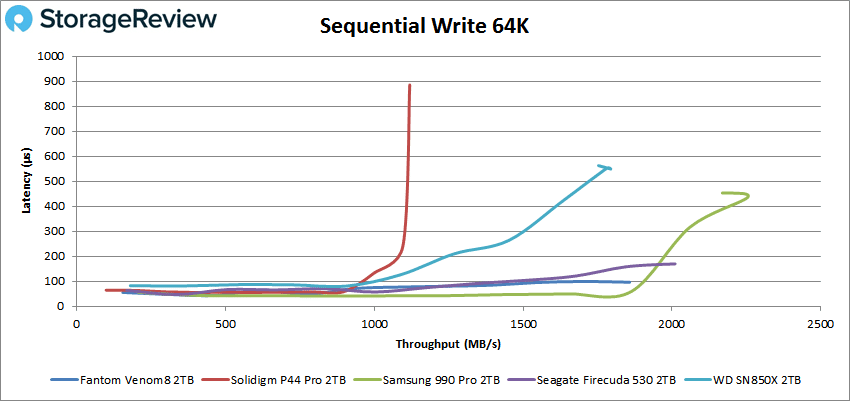
Next, we looked at our VDI benchmarks, which are designed to tax the drives even further. These tests include Boot, Initial Login, and Monday Login. Starting with Boot, the Fantom VENOM8 had a peak of 163K IOPS with a latency of 193.2µs, though it had a slight spike in performance at the end.
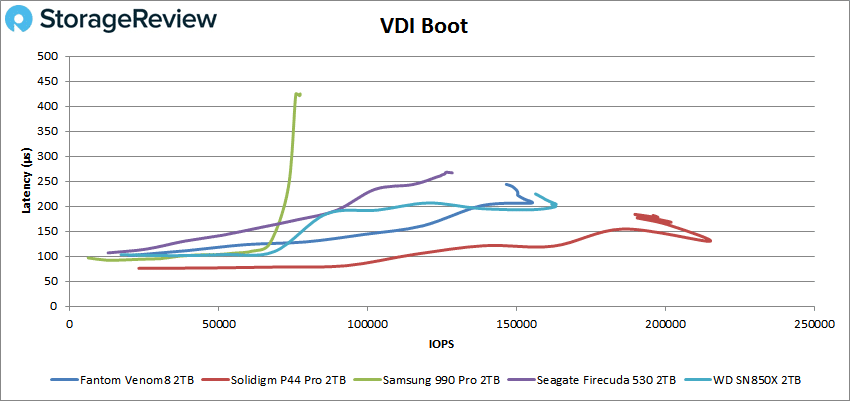
Our VDI Initial Login produced some messy results in our charts (as per usual). The Fantom VENOM8 had a peak of 32K IOPS with a latency of 933.1µs, though it ended at 28K IOPS. These were lower-tier results compared to the rest of the SSDs.
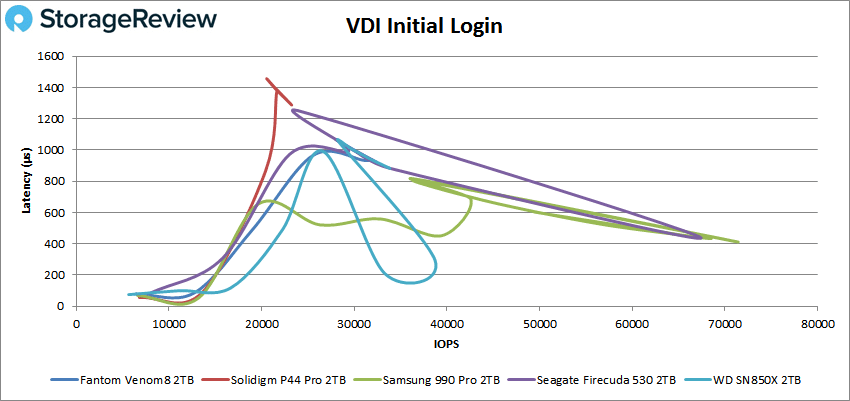
Finally, VDI Monday Login (again, results were hard to decipher unless you had the source files) saw the Fantom VENOM8 peak at 21K IOPS (near the back of the pack) with a latency of 742.8µs, which were one of the weaker results.
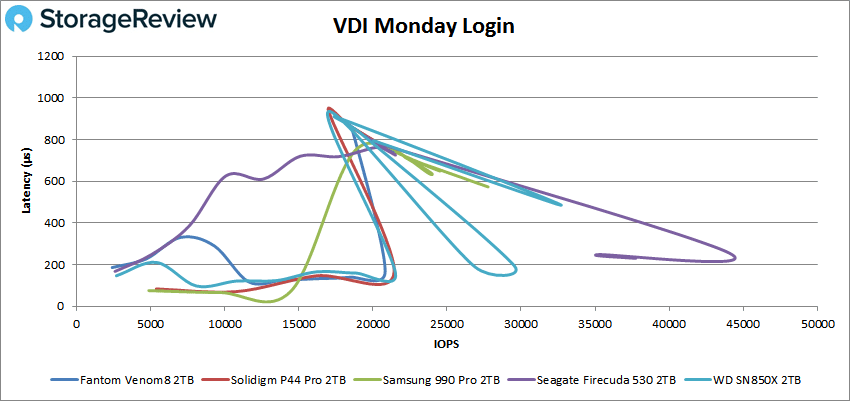
Fantom Drives VENOM8 Blackmagic Disk Speed Test
We measured performance inside a Windows 11 environment on our consumer test platform via the popular Blackmagic test. Here, the Fantom VENOM8 was able to reach 5.21GB/s read and 6.02GB/s write.
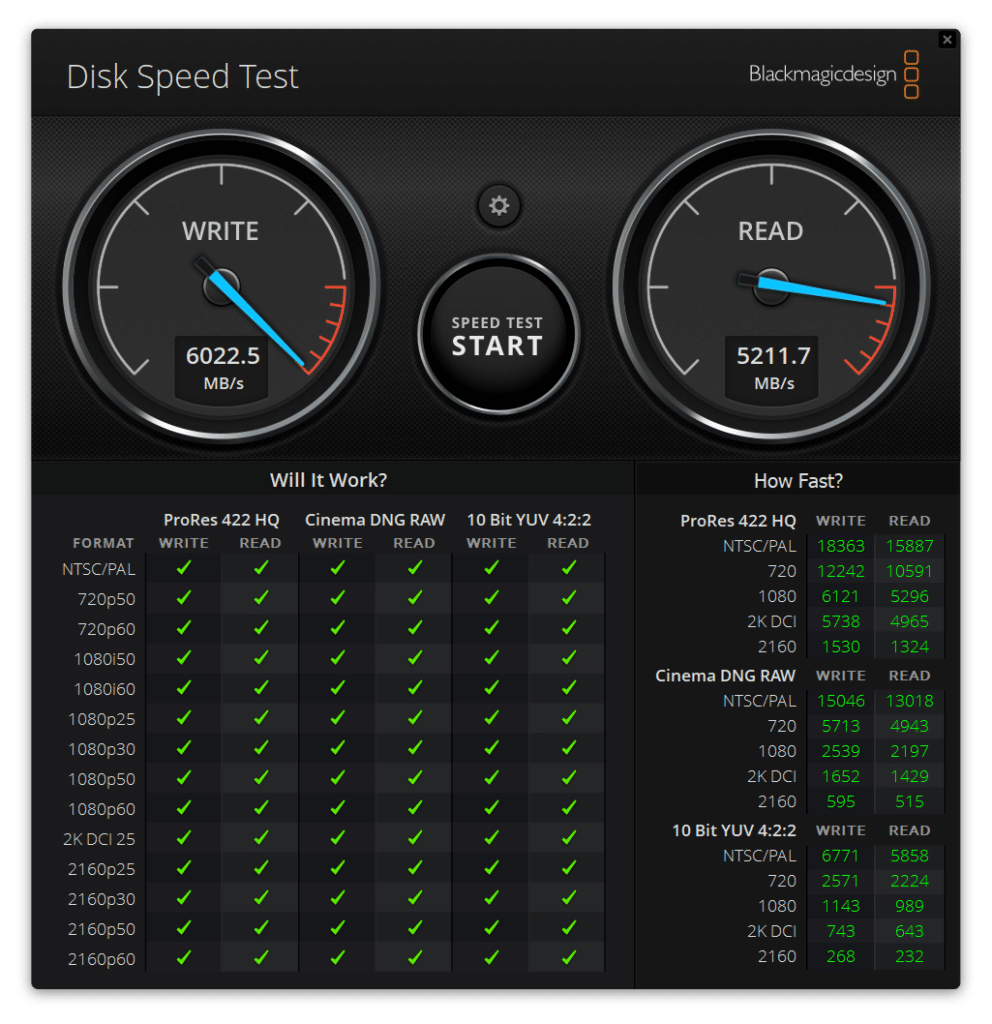
While reads were slightly lower than other premium PCIe Gen4 drives we tested (for example, the Samsung Pro posted 5.67GB/s), its write activity was among the leaders.
Conclusion
The Fantom VENOM8 is a strong entry into the increasingly competitive consumer PCIe Gen4 SSD market. Available in capacities ranging from 1TB to 4TB, this new enthusiast drive features 176-Layer 3D NAND technology, SK Hynix DDR4 DRAM Cache, and a Phison E18 controller. It also comes with the usual advanced feature set, including TRIM and SMART support, AES 256-Bit encryption, Autonomous Power State Transition (APST), End-to-end data path protection, and LDPC ECC algorithm.
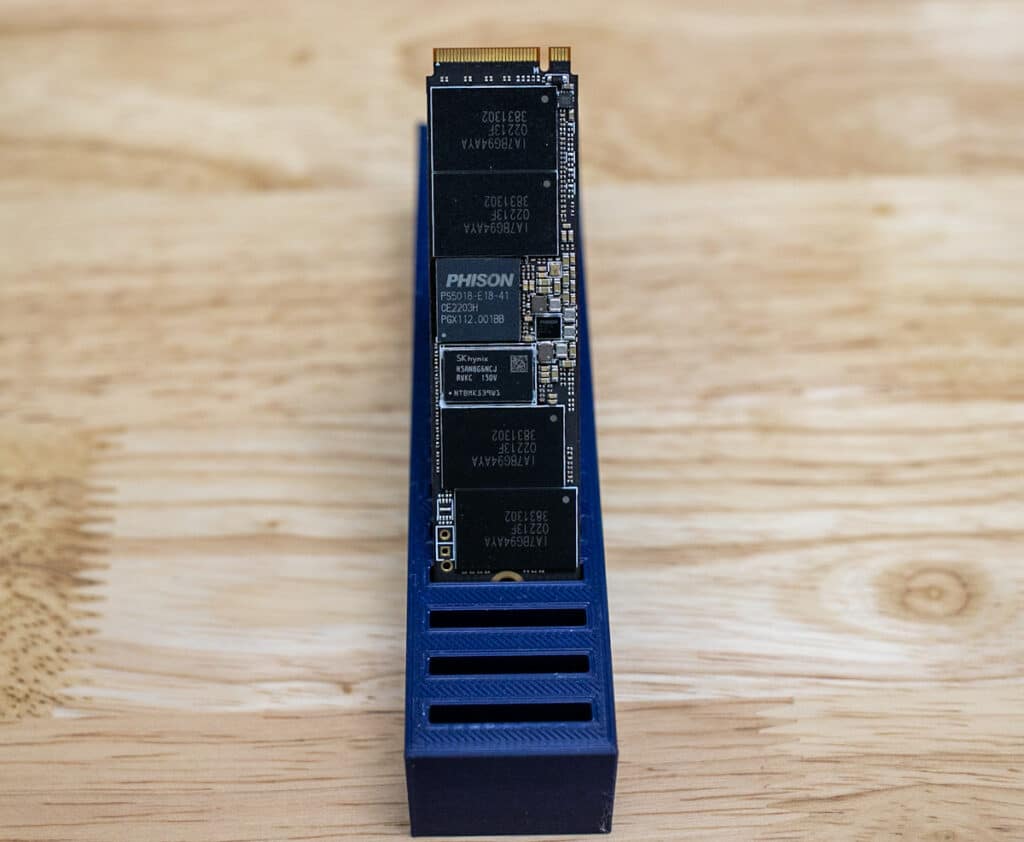
As far as performance goes, it certainly held its own in most of our workload tests often finding itself among the leaders or in the middle of the pack. Highlights included: 679K IOPS in 4K read, a leading 598K IOPS in 4K write, 5.6GB/s in 64K read, and 1.86GB/s in 64K write. In our VDI tests, we saw 163K IOPS in boot, 32K IOPS in initial login, and 21K IOPS in Monday login. The results of our Blackmagic test were also very strong, posting 5.21GB/s read and 6.02GB/s write, which was up there with some of the best-performing write speeds we’ve seen with consumer drives.
For our BootBench test (which gauges a drive’s usefulness for server booting), the Fantom VENOM8 posted mid-range results with 190,573 IOPS. While this result trailed the recent SK Hynix, WD, and Solidigm SSDs, it did outperform the Samsung 990 Pro by roughly 15K IOPS.
Ultimately, the end user may not “feel” the difference with these high-performance drives as the performance profiles are extremely competitive. This means pricing is one of the most important factors for many. The Fantom VENOM8 currently goes for an MSRP of $105 (1TB) and $205 (2TB). In comparison, the Solidigm P44 Pro is slightly more expensive at $129.99 and $234.99 for the 1TB and 2TB models, respectively. Moreover, the SK hynix Platinum P41 and Samsung 990 Pro are the most expensive of the bunch, currently going for $150 (1TB) / $254 (2TB), and $170 (1TB) / $290 (2TB), respectively.
This makes the Fantom VENOM8 the most affordable premium PCIe Gen4 SSD available. This is actually pretty interesting, Fantom must be taking a loss, or at best breaking even, on these drives to get their name out there. We’ll be interested to see what their pricing looks like long-term and how much they choose to expand their SSD investment over time.
Coupling this market-leading pricing with its solid performance profile and advanced feature set makes the Fantom VENOM8 a great choice for users looking to build a high-end PC.




 Amazon
Amazon